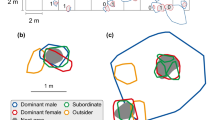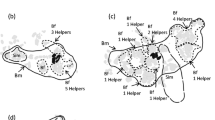Abstract
It is suggested that some fish of the genus Julidochromis, substrate-brooding Tanganyikan cichlids with biparental care, breed cooperatively with helpers. We studied the social system of J. ornatus in the wild and analysed genetic parentage using microsatellites. Within the studied population three patterns of social system were identified: monogamous pairs (61%, 44 of 72 groups), pairs with helpers (29%, 21), and polygamous harems with helpers (controlled by either a large female or large male owner; 10%, 7). In cooperatively breeding groups, the number of helpers at each nest ranged from 1 to 6 (median 1), and male helpers were more numerous than female helpers. In both sexes, the body size was different among individuals of different social status (harem owner > breeder > helper). Helpers and harem owners of both sexes exhibited brood defence although its frequency was low. The molecular analysis revealed that (1) the helpers were mostly unrelated to dominant breeders, (2) many helpers of both sexes contributed genetically to the next generations, (3) male helpers had high siring success (41% of young in total), and (4) large young unrelated to group members were detected at 30% of observed nests, which may be due to breeder (or helper) replacements and immigration of young. We discuss the implications of these results for understanding the complex social system of this species, especially the low reproductive skew in comparison with other cooperatively breeding cichlids.


Similar content being viewed by others
References
Akane A, Matsubara K, Shiono H (1992) Investigation of algorithm for the calculation of probability of paternity likelihood using personal computer program, including the application to parentage testing in the deceased party. Jpn J Legal Med 46:254–265
Awata S, Kohda M (2004) Parental roles and the amount of care in a bi-parental substrate brooding cichlid: the effect of size differences within pairs. Behaviour 141:1135–1149
Balshine S, Leach B, Neat F, Reid H, Taborsky M, Werner N (2001) Correlates of group size in a cooperatively breeding cichlid fish (Neolamprologus pulcher). Behav Ecol Sociobiol 50:134–140
Balshine-Earn S, Neat FC, Reid H, Taborsky M (1998) Paying to stay or paying to breed? Field evidence for direct benefits of helping behavior in a cooperatively breeding fish. Behav Ecol 9:432–438
Barlow GW (1991) Mating systems among cichlid fishes. In: Keenleyside MHA (ed) Cichlid fishes: behaviour, ecology and evolution. Chapman and Hall, London, pp 173–190
Bergmüller R, Taborsky M (2005) Experimental manipulation of helping in a cooperative breeder: helpers ‘pay to stay’ by pre-emptive appeasement. Anim Behav 69:19–28
Bergmüller R, Heg D, Taborsky M (2005) Helpers in a cooperatively breeding cichlid stay and pay or disperse and breed, depending on ecological constraints. Proc R Soc Lond B 272:325–331
Burke T, Davies NB, Bruford MW, Hatchwell BJ (1989) Parental care and mating behaviour of polyandrous dunnocks Prunella modularis related to paternity by DNA fingerprinting. Nature 338:249–251
Cant MA (1998) A model for the evolution of reproductive skew without reproductive suppression. Anim Behav 55:163–169
Davies NB (1992) Dunnock behaviour and social evolution. Oxford University Press, Oxford
Dierkes P, Taborsky M, Kohler U (1999) Reproductive parasitism of broodcare helpers in a cooperatively breeding fish. Behav Ecol 10:510–515
Essen-Möller E (1938) Die Beweiskraft der Ähnlichkeit im Vaterschaftsnachweis. Theoretische Grundlagen. Mitt Anth Ges Wien 68:9–53
Faaborg J, Parker PG, DeLay L, de Vries T, Bednarz JC, Maria Paz S, Naranjo J, Waite TA (1995) Confirmation of cooperative polyandry in the Galapagos hawk (Buteo galapagoensis). Behav Ecol Sociobiol 36:83–90
Goldizen AW, Buchan JC, Putland DA, Goldizen AR, Krebs EA (2000) Patterns of mate-sharing in a population of Tasmanian native hens Gallinula mortierii. Ibis 142:40–47
Heg D, Bachar Z, Brouwer L, Taborsky M (2004) Predation risk is an ecological constraint for helper dispersal in a cooperatively breeding cichlid. Proc R Soc Lond B 271:2367–2374
Jamieson IG (1997) Testing reproductive skew models in a communally breeding bird, the pukeko, Porphyrio porphyrio. Proc R Soc Lond B 264:335–340
Jamieson IG, Quinn JS, Rose PA, White BN (1994) Shared paternity among non-relatives is a result of an egalitarian mating system in a communally breeding bird, the pukeko. Proc R Soc Lond B 257:271–277
Johnstone RA (2000) Models of reproductive skew: a review and synthesis. Ethology 106:5–26
Keller L, Reeve HK (1994) Partitioning of reproduction in animal societies. Trends Ecol Evol 9:98–102
Kohda M, Yanagisawa Y, Sato T, Nakaya K, Niimura Y, Matsumoto K, Ochi H (1996) Geographical colour variation in cichlid fishes at the southern end of Lake Tanganyika. Environ Biol Fish 45:237–248
Kohler U (1998) Zur Struktur und Evolution des Sozialsystems von Neolamprologus multifasciatus (Cichlidae, Pisces), dem kleinsten Schneckenbuntbarsch des Tanganjikasees. Aachen, Shaker
Kondo T (1986) Feeding habits of Lamprologus savoryi (Teleostei: Cichlidae) with reference to its social behaviour. Physiol Ecol Jpn 23:1–15
Konings A (1998) Tanganyika cichlids in their natural habitat. Cichlid Press, El Paso, Texas
Kuwamura T (1997) The evolution of parental care and mating systems among Tanganyikan cichlids. In: Kawanabe H, Hori M, Nagoshi M (eds) Fish communities in Lake Tanganyika. Kyoto University Press, Kyoto, Japan, pp 57–86
Limberger D (1983) Pairs and harems in a cichlid fish, Lamprologus brichardi. Z Tierpsychol 62:115–144
Martin E, Taborsky M (1997) Alternative male mating tactics in a cichlid, Pelvicachromis pulcher: a comparison of reproductive effort and success. Behav Ecol Sociobiol 41:311–319
Munehara H, Awata S, Katoh R, Kohda M, Sunobe T (2001) Primer sequences and cross-species amplification for parentage discrimination of Tanganyikan cichlid fishes. Bull Fac Fish Hokkaido Univ 52:131–133
Munehara H, Takenaka O (2000) Microsatellite markers and multiple paternity in a paternal care fish, Hexagrammos otakii. J Ethol 18:101–104
Ota M, Matsuzawa T, Fukushima H, Yonemura I, Hasekura H (1986) Personal computer program calculating the probability of paternity considering the recombination rates between HLA-A and B loci. Jpn J Legal Med 40:774–781
Põldmaa T, Montgomerie R, Boag P (1995) Mating system of the cooperatively breeding noisy miner Manorina melanocephala, as revealed by DNA profiling. Behav Ecol Sociobiol 37:137–143
Reeve HK, Emlen ST, Keller L (1998) Reproductive sharing in animal societies: reproductive incentives or incomplete control by dominant breeders? Behav Ecol 9:267–278
Rice WR (1989) Analyzing tables of statistical tests. Evolution 43:223–225
SAS Institute, Inc. (1998) Statview for Macintosh, version 5.0. SAS Institute Inc., Cary, NC
Schradin C, Lamprecht J (2002) Causes of female emigration in the group-living cichlid fish Neolamprologus multifasciatus. Ethology 108:237–248
Skubic E, Taborsky M, McNamara JM, Houston AI (2004) When to parasitize? A dynamic optimization model of reproductive strategies in a cooperative breeder. J Theor Biol 227:487–501
Stiver KA, Dierkes P, Taborsky M, Balshine S (2004) Dispersal patterns and status change in a co-operatively breeding cichlid Neolamprologus pulcher: evidence from microsatellite analyses and behavioural observations. J Fish Biol 65:91–105
Sunobe T (2000) Social structure, nest guarding and interspecific relationships of the cichlid fish (Julidochromis marlieri) in Lake Tanganyika. Afr Study Monogr 21:83–89
Sunobe T, Munehara H (2003) Mating system and kin relationship between adults and young in the shell-brooding cichlid fish Neolamprologus meeli in Lake Tanganyika. J Ethol 21:87–92
Taborsky M (1984) Broodcare helpers in the cichlid fish Lamprologus brichardi: their costs and benefits. Anim Behav 32:1236–1252
Taborsky M (1985) Breeder-helper conflict in a cichlid fish with broodcare helpers: an experimental analysis. Behaviour 95:45–75
Taborsky M (1994) Sneakers, satellites, and helpers: parasitic and cooperative behavior in fish reproduction. Adv Study Behav 23:1–100
Taborsky M (1999) Conflict or cooperation: what determines optimal solutions to competition in fish reproduction? In: Almada VC, Oliveira RF, Goncalves EJ (eds) Behaviour and conservation of littoral fishes. ISPA, Lisbon, pp 301–349
Taborsky M (2001) The evolution of bourgeois, parasitic, and cooperative reproductive behaviors in fishes. J Hered 92:100–110
Taborsky M, Limberger D (1981) Helpers in fish. Behav Ecol Sociobiol 8:143–145
Vehrencamp SL (1983) Optimal degree of skew in cooperative societies. Am Zool 23:327–335
Whittingham LA, Dunn PO, Magrath RD (1997) Relatedness, polyandry and extra-group paternity in the cooperatively-breeding white-browed scrubwren (Sericornis frontalis). Behav Ecol Sociobiol 40:261–270
Yamagishi S, Kohda M (1996) Is the cichlid fish Julidochromis marlieri polyandrous? Ichthyol Res 43:469–471
Acknowledgements
We thank the staff of Lake Tanganyika Research Unit for assistance in the field. We are also grateful to Tatiana Czeschlik, Mark Abrahams, Michael Taborsky, and two anonymous referees for helpful comments and suggestions on the manuscript, and Andrew Rossiter, Karen D. Crow, John Bower, Masaoki Takagi, Kazunori Matsumoto, and Natori Yasuo for advice and comments on a previous version of this manuscript. This study was financially supported by a Grant-in-Aid for Overseas Scientific Research (no. 10041178) from the Japanese Ministry of Education, Science, Sports, and Culture.
Author information
Authors and Affiliations
Corresponding author
Additional information
Communicated by M. Abrahams
Rights and permissions
About this article
Cite this article
Awata, S., Munehara, H. & Kohda, M. Social system and reproduction of helpers in a cooperatively breeding cichlid fish (Julidochromis ornatus) in Lake Tanganyika: field observations and parentage analyses. Behav Ecol Sociobiol 58, 506–516 (2005). https://doi.org/10.1007/s00265-005-0934-6
Received:
Revised:
Accepted:
Published:
Issue Date:
DOI: https://doi.org/10.1007/s00265-005-0934-6




